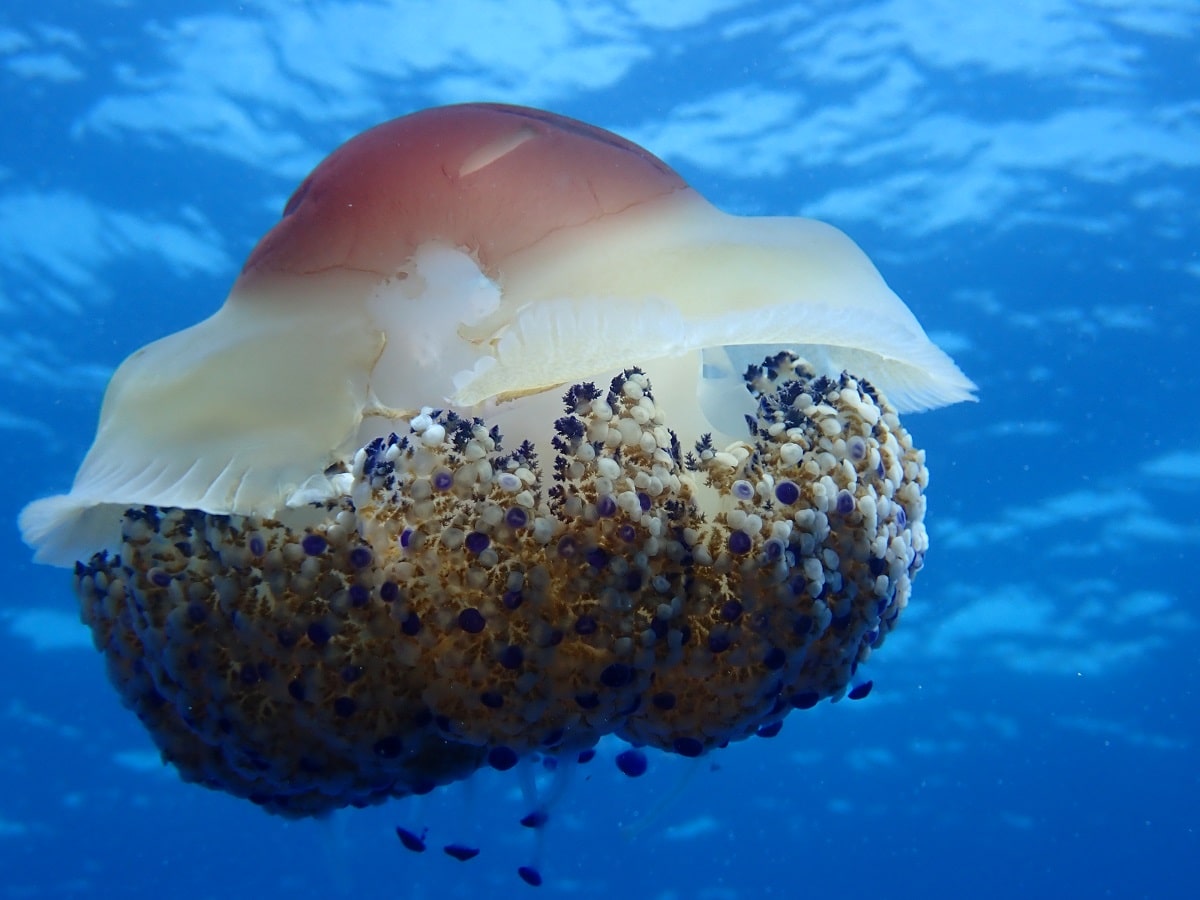See The Fried Egg Jellyfish: Facts & More!
Cotylorhiza tuberculata is a jellyfish species characterized by a distinctive morphology. Its bell, a yellowish-brown color with a central, raised dome, resembles the appearance of a cooked egg. This species, often observed in warmer waters, particularly the Mediterranean Sea, is recognized for its relatively mild sting compared to some other jellyfish types.
These marine organisms play a role in the oceanic ecosystem, serving as a food source for some species and contributing to nutrient cycling. Their presence, particularly during seasonal blooms, can influence plankton populations and water clarity. Historically, observations of this particular jellyfish have been documented in various scientific studies and marine biodiversity surveys, providing insights into its distribution and behavior.
The subsequent discussion will delve into the species' life cycle, feeding habits, habitat, and interactions with other marine life. A further examination of the ecological factors influencing its population dynamics and its potential impact on human activities will also be presented.
- M I A Rapper Family Husband Children
- Here S How Much Mia Farrow Is
- Nico Parker Bio Age Career Height Single
- Harley West Bio Wikipedia Age Height Boyfriend
- Rosie Langley Height Weight Net Worth Age
Frequently Asked Questions Regarding Cotylorhiza tuberculata
The following addresses common inquiries concerning the jellyfish species Cotylorhiza tuberculata, known for its distinctive appearance.
Question 1: What is the geographic distribution of Cotylorhiza tuberculata?
This species is primarily found in the Mediterranean Sea and the Adriatic Sea, though its range can extend to other areas with similar water temperatures and environmental conditions.
- Chuck Todd And Wife Kristian Todd Married
- Brantley Gilbert Age Net Worth Kids Weight
- Xochitl Gomez Siblings Does She Have Any
- Justin Leonard Golf Channel Bio Wiki Age
- Sharon Case Net Worth Husband Married Children
Question 2: Is Cotylorhiza tuberculata dangerous to humans?
The jellyfish's sting is generally considered mild compared to other jellyfish species. Contact may cause slight irritation or a tingling sensation, but severe reactions are rare.
Question 3: What is the primary diet of Cotylorhiza tuberculata?
These jellyfish primarily feed on plankton, small crustaceans, and other microscopic organisms that drift in the water column. They utilize their tentacles to capture and consume their prey.
Question 4: What is the typical lifespan of Cotylorhiza tuberculata?
The lifespan is relatively short, typically lasting for only a few months. They appear seasonally, usually during warmer months, and their populations decline as water temperatures decrease.
Question 5: What are the main predators of Cotylorhiza tuberculata?
Sea turtles and some fish species are known to prey on these jellyfish. Their vulnerability to predation can influence their population dynamics within the marine ecosystem.
Question 6: How does Cotylorhiza tuberculata reproduce?
Reproduction involves both sexual and asexual phases. The medusa stage reproduces sexually, releasing eggs and sperm into the water. The resulting larvae settle and develop into polyps, which can reproduce asexually to create new medusae.
In summary, Cotylorhiza tuberculata is a jellyfish species characterized by its limited geographic distribution, mild sting, planktonic diet, and relatively short lifespan. Its role in the marine ecosystem, as both predator and prey, contributes to the overall biodiversity of its habitat.
The subsequent section will explore the conservation status and potential threats facing Cotylorhiza tuberculata populations.
Considerations Regarding Cotylorhiza tuberculata Encounters
The following outlines key considerations for areas where Cotylorhiza tuberculata, commonly referred to as a jellyfish with a distinctive appearance, may be present.
Tip 1: Recognize the Appearance. Accurate identification is crucial. Familiarize oneself with the physical characteristics, including the yellowish-brown bell and raised central dome, to distinguish it from other jellyfish species.
Tip 2: Exercise Caution While Swimming. Although the sting is generally mild, individuals with sensitive skin or allergies should exercise caution when swimming in areas known to harbor this jellyfish.
Tip 3: Avoid Direct Contact. Direct physical contact should be minimized. Even a mild sting can cause discomfort, particularly for children or individuals with pre-existing skin conditions.
Tip 4: Understand Seasonal Abundance. Be aware that populations often fluctuate seasonally, with increased prevalence during warmer months. Monitor local reports regarding jellyfish activity.
Tip 5: Implement Protective Measures. When engaging in water activities, consider wearing appropriate protective clothing, such as wetsuits or rash guards, to minimize potential contact.
Tip 6: Monitor Children Closely. Supervision of children is essential, particularly in areas with known populations. Educate children on the importance of avoiding contact with marine life.
Tip 7: Report Unusual Sightings. Document and report unusually high concentrations or atypical behavior to local marine authorities or environmental agencies. This contributes to monitoring and research efforts.
These considerations emphasize the importance of awareness and proactive measures when in environments where Cotylorhiza tuberculata may be encountered. Implementing these guidelines can contribute to a safer and more informed experience.
The final section will summarize the key aspects covered in this discussion.
Conclusion
This exploration has detailed the characteristics, ecological role, and human interactions associated with the Cotylorhiza tuberculata, commonly recognized as the "fried egg jellyfish." The species' distinctive morphology, mild sting, and seasonal abundance have been examined, alongside its importance as both predator and prey within marine ecosystems. Furthermore, guidelines for safe encounters and considerations for conservation have been presented.
Continued research and monitoring are crucial to understand the long-term impacts of environmental changes on this jellyfish and other marine organisms. By fostering a greater understanding of the "fried egg jellyfish" and its place in the natural world, informed decisions can be made to ensure the health and resilience of coastal environments.
- Emily Willis Net Worth Wiki Age Weight
- Duane Underwood Jr Family Parents Ethnicity Where
- Paula Harwood Bio Net Worth Height Career
- Christian Kirk Wife To Be Ozzy Ozkan
- Ciara Ethnicity Nationality Race Family Body Measurements

Fried Egg Jellyfish (Cotylorhiza tuberculata) Atlantis Gozo Diving Malta

Fried Egg Jellyfish About Cotylorhiza tuberculata Snorkel Things

Fried Egg Jellyfish Are Kind of Adorable & That's No Yolk.